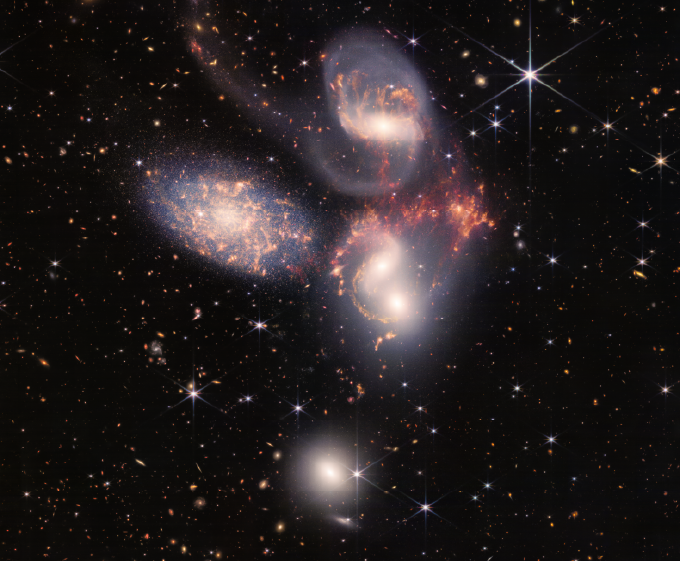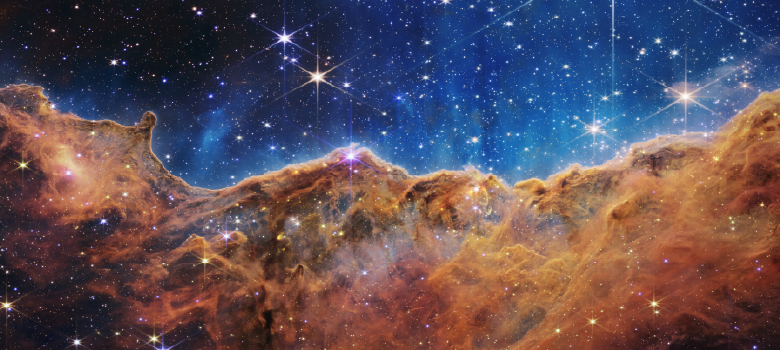
Stephan’s Quintet is a group of five galaxies interacting with each other in the company of old stars, evidenced by their red hue, and newly formed stars in blue.
JULY 12, 2022 — Chris Packham, professor and astrophysicist in the UTSA Department of Physics and Astronomy, was astounded at the sights of the newly revealed galactic images from the James Webb Space Telescope (JWST) Tuesday morning.
After watching the 25 years of development, Packham and others around the world found themselves experiencing history as NASA shared the JWST’s first five highly detailed images from space, unveiling the farthest corners of the cosmos.
Among the images is Stephan’s Quintet, a group of five galaxies interacting with each other in the company of old stars, evidenced by their red hue, and newly formed stars in blue. But the background of the photo was what brought Packham to his feet toward his 55-inch TV screen. There was no more blank sky—only galaxies.
“This is totally transformative,” Packham said. “We’ll have to change the way we ‘do’ science. This is a major moment for astronomy with the potential to transform, and when combined with improved techniques and approaches to harness the true power of the data, this is a game-changer! This will only get better from here on. The wealth of sensitive spatial information is incredible.”

This landscape of “mountains” and “valleys” speckled with glittering stars is actually the edge of a nearby, young, star-forming region called NGC 3324 in the Carina Nebula. Captured in infrared light by NASA’s new James Webb Space Telescope, this image reveals for the first time previously invisible areas of star birth.
The JWST launched Christmas Day 2021 aboard a rocket in French Guinea. The telescope is the largest and most powerful space science telescope in (and out of) the world, efficiently producing images of space with the sharpest details. It took 12.5 hours for the JWST to produce the deepest ever infrared image (released July 12) of the furthest corners of space, considerably less time than its predecessor, the Hubble Deep Field, which took 10 consecutive days to capture an image created from exposures taken in 1995.
In the coming months, Packham will delve into these and other observations alongside a team of international scientists that is conducting research on supermassive black holes. The team, which Packham co-leads, is called Galactic Activity, Torus and Outflow Survey, or GATOS. By July 14, they will have access to the first part of their awarded data of galaxies that host supermassive black holes, as revealed by the JWST.
GATOS is one of a select number of teams awarded access to the Webb telescope for research. The team was granted a total of 53 hours on the telescope to collect data.
“This is only the beginning. It’s beyond what we had expected—it’s beyond our dreams,” Packham said.
UTSA Today is produced by University Communications and Marketing, the official news source of The University of Texas at San Antonio. Send your feedback to news@utsa.edu. Keep up-to-date on UTSA news by visiting UTSA Today. Connect with UTSA online at Facebook, Twitter, Youtube and Instagram.
Move In To COLFA is strongly recommended for new students in COLFA. It gives you the chance to learn about the Student Success Center, campus resources and meet new friends!
Academic Classroom: Lecture Hall (MH 2.01.10,) McKinney Humanities BldgWe invite you to join us for Birds Up! Downtown, an exciting welcome back event designed to connect students with the different departments at the Downtown Campus. Students will have the opportunity to learn about some of the departments on campus, gain access to different resources, and collect some giveaways!
Bill Miller PlazaJoin us for an intimate evening of cocktails, conversation, and culinary inspiration with Pati Jinich, Emmy-nominated chef and James Beard Award-winning author. Enjoy light bites and signature drinks in the warm, modern setting of Mezquite as Pati connects with guests over her passion for Mexican cuisine and storytelling.
Mezquite Restaurant in Pullman Market, 221 Newell Ave., San Antonio 78215From inspired courses to thoughtful pairings and a rich sense of community, the Ven a Comer Signature Dinner is a night of shared meals, shared stories, and unforgettable flavor.
Stable Hall (Pear Brewery), 307 Pearl Pkwy, San Antonio 78215Come and celebrate this year's homecoming at the Downtown Campus with food, games, giveaways, music, and more. We look forward to seeing your Roadrunner Spirit!
Bill Miller PlazaThe University of Texas at San Antonio is dedicated to the advancement of knowledge through research and discovery, teaching and learning, community engagement and public service. As an institution of access and excellence, UTSA embraces multicultural traditions and serves as a center for intellectual and creative resources as well as a catalyst for socioeconomic development and the commercialization of intellectual property - for Texas, the nation and the world.
To be a premier public research university, providing access to educational excellence and preparing citizen leaders for the global environment.
We encourage an environment of dialogue and discovery, where integrity, excellence, respect, collaboration and innovation are fostered.